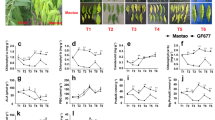Abstract
A mutant muskmelon (Cucumis melo L.) with characteristic Fe-deficiency chlorosis symptoms was compared to related cultivars in its ability to obtain Fe via the widely known Fe-stress response mechanisms of dicotyledonous plants. The three cultivars (fefe, the ‘Fe-inefficient’ mutant; Mainstream and Edisto, both ‘Fe efficient’ plants) were grown in nutrient solution in either 0 or 3.5 mg L-1 Fe as FeCl3. None of the three cultivars released ‘reductants’ or ‘phytosiderophores’, but both Edisto and Mainstream produced massive amounts of H+ ions to reduce and maintain the pH of nutrient solutions below pH 4.0. The roots of these two Fe-efficient cultivars were also capable of reducing Fe3+ to Fe2+. These responses maintained green plants, resulted in high leaf Fe in both Edisto and Mainstream, and produced Mn toxicity in Mainstream. The lack of Fe-deficiency stress response in fefe not only affected leaf Fe concentration and chlorosis, but also resulted in reduced uptake of Mn. The importance of reduced Fe (Fe2+) to the Fe-efficient cultivars was confirmed by growing the cultivars with BPDS (4, 7-diphenyl-1, 10-phenanthroline disulfonic acid, a ferrous chelator) and EDDHA [ethylene-diamine di (0-hydroxphenylacetic acid)] (a ferric chelator), and observing increased chlorosis and reduced Fe uptake in BPDS grown plants. The Fe-deficiency response observed in these cultivars points out the diversity of responses to Fe deficiency stress in plants. The fefe mutant has a limited ability to absorb Fe and Mn and perhaps could be used to better understand Mn uptake in plants.
Similar content being viewed by others
References
Brown J C 1978 Mechanism of iron uptake by plants. Plant Cell Environ. 1, 249–257.
Brown J C, Chaney R L and Ambler J E 1971 A new tomato mutant inefficient in transport of iron. Physiol. Plant. 25, 48–53.
Camp S D, Jolley V D and Brown J C 1987 Comparative evaluation of factors involved in Fe stress response in tomato and soybean J. Plant Nutr. 10, 423–442.
Hoagland D R and Arnon D I 1950 The water culture method for growing plants without soil. Circ. 347, Calif. Agric. Expt. Stn., Berkeley, CA.
Jolley V D, Brown J C and Blaylock M J 1988 An iron chelating compound released by barley roots in response to Fe-deficiency stress. J. Plant Nutr. 11, 77–91.
Nugent P E and Bhella H S 1988 A new chlorotic mutant of muskmelon. HortScience 23, 379–381.
Olsen R A and Brown J C 1980 Factors related to iron uptake by dicotyledonous and monocotyledonous plants. I. pH and reductant. J. Plant Nutr. 2, 629–645.
Steinberg R A 1953 Symptoms of molybdenum deficiency in tobacco. Plant Physiol. 28, 319–322.
Author information
Authors and Affiliations
Rights and permissions
About this article
Cite this article
von Jolley, D., Brown, J.C. & Nugent, P.E. A genetically related response to iron deficiency stress in muskmelon. Plant Soil 130, 87–92 (1991). https://doi.org/10.1007/BF00011860
Issue Date:
DOI: https://doi.org/10.1007/BF00011860




